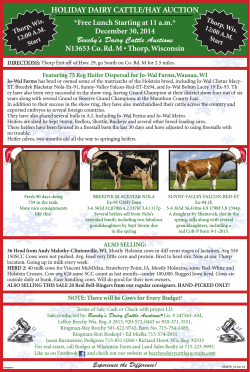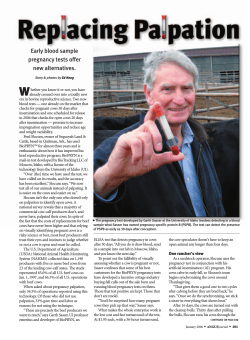
Dr. Dennis G. Bardelmeier, DVM Ph.715-316-2369 P.O. Box 366 Ph. 715-223-4700
Dr. Dennis G. Bardelmeier, DVM Ph.715-316-2369 P.O. Box 366 413 South 4th Street Abbotsford, WI 54405 Ph. 715-223-4700 Fax. 715-223-4711 info@northernlakesvet.com DIARRHEA IN COWS TREATMENT PROTOCOLS Diarrhea in cows has many causes. Treatment in many cases is symptomatic and supportive rather than specific. Identifying the cause of diarrhea and developing a plan for prevention or, at least, control, is most important. Johne’s disease is a disease of chronic diarrhea, weight loss, and poor production. It is acquired as calves but often does not cause illness until later in life. No effective treatment is available but numerous control procedures are available. The mainstays of prevention are identification of infected animals and preventing exposure of calves and young stock to the manure of older animals. In certain situations, with state approval, vaccination can beneficial. Winter dysentery is a suddenly occurring disease with diarrhea affecting large portions of the herd. Diarrhea tends to be explosive and frequently contains blood and mucus. The condition usually lasts for a few days and causes large drops in production. Death is rare. Sometimes, a corona virus is incriminated but there are likely many different causes. In the past, over-thecounter anti-diarrhea boluses were commonly used. These coat and protect the lining of the intestine but do not alter the course of the disease. This treatment is indicated for cows that are passing large amounts of blood but typically are not practical or useful for herd treatment. Antibiotics are of limited value except in cases that pass large amounts of blood or in herds with known salmonellosis problems; the goal is to prevent bacteria from entering the bloodstream through the damaged intestinal lining. Usually, antibiotics with no milk withholding such as Naxcel, Excenel, Certiflex, or Excede are used at a dose based on body weight. Winter dysentery rarely requires extensive supportive treatment like intravenous fluids. If cows are running fevers, aspirin or Banamine(Flunixin) (WITHHOLDING), again at a dose determined by weight, can be helpful. Often, increasing the amount of dry hay and decreasing the amount of fermented feed in the ration is helpful. Allowing free-choice salt can help minimize milk production losses. Salmonellosis is an increasingly recognized disease of dairy cattle. It typically causes fever, diarrhea, and sometimes pneumonia and abortion. Although it is a herd problem, usually a large percentage of the herd will not be sick at one time as is the case with winter dysentery. Diagnosis is confirmed by culturing the manure or from tissue obtained from a post-mortem examination. Recovered cows can be asymptomatic carriers, maintaining the disease in the herd. Vaccines like SRP and J-5 both help minimize the effects of the disease rather than truly preventing infection but are an important part of management. Antibiotic therapy is best based on culture and sensitivity reports but, in their absence, antibiotic and anti-inflammatory therapy as described above should be started. Salmonellosis is likely to require more supportive therapy because dehydration is more likely. Hypertonic saline, given at a rate of 2 one-liter bottles once or twice daily, intravenously, will help but the cow must be able to get up and drink afterwards. If she is down, pumping her stomach with 10 gallons of water, with electrolytes and pro-biotics is necessary. Salmonellosis can affect humans so good hygiene for farm workers is a must. Dr. Dennis G. Bardelmeier, DVM Ph.715-316-2369 There are many other causes of diarrhea in cows including BVD, IBR, and moldy feed. Specific preventive measures, when available, are best, because treatment is again mainly supportive. An emerging intestinal disease of cows (although not typically resulting in significant diarrhea) is jejunal hemorrhage syndrome or hemorrhagic bowel disease. Massive bleeding into the small intestine occurs, causing a blockage. The cow can be in shock. Sometimes, a small amount of bloody fluid will be passed rectally. Current thought incriminates Clostridum perfringens Type A with or without high levels of aflatoxin in the ration. Treatment is supportive and often unrewarding, although surgical removal of the blood clots has been performed successfully. Most of these cows are too sick to be surgical candidates.
© Copyright 2025





















